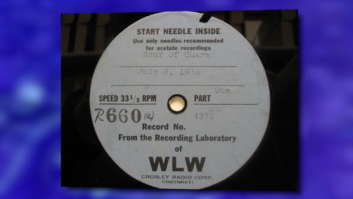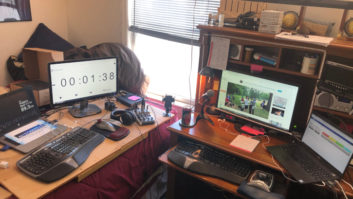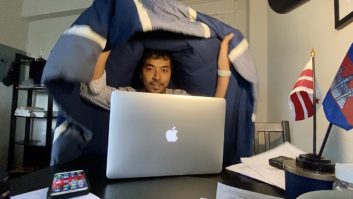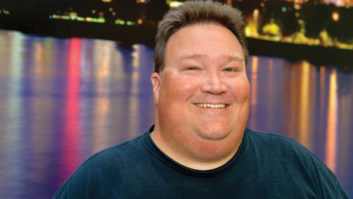Travis Gilmour is co-owner of Video Dads, an Emmy award-winning production company specializing in video storytelling for documentary, corporate and public media clients. Video Dads also run the site geardads.com, which provide video and audio gear reviews for professional media producers.

This story appeared in the Radio World eBook “Visual Radio 2018.”
Radio World: Having spent a lot of time with radio people seeking to think visually, what advice can you offer?
Travis Gilmour: As a professional video producer, media trainer and fellow storyteller, the biggest advice I give to folks looking to get into more visual forms of storytelling is “go for it.” The beauty of this advice in 2018 is that it doesn’t come with a built-in gear purchase checklist, a list of specific software to master or any of the budgetary and planning questions that came along with that even a few years ago.
With the ubiquitous availability of excellent tools (smartphones) and platforms (Facebook, Instagram, YouTube, traditional blogging), the essential key is to do what you already do best: Find the most compelling stories you can and tell them. And if you think about it, seasoned reporters and other radio talent, regardless of background, actually have an edge over the masses of newbies diving in to the storytelling profession every day: You have the experience, the story ideas and associated contacts, and an established audience and their trust.
Of course, this is not denying that there is a definite path towards improving, building audience, dedicating more and more time to the craft of visual content production, using more professional gear, mortgaging your house to purchase said gear, etc. But when asked, “How do I start on my journey to becoming a visual storyteller,” the answer is in the question: Start!
RW: Can you give examples of radio organizations “thinking visually”? Through what tools or platforms?
Gilmour: I’ll answer in a roundabout kind of way by talking about how I use and think about social media platforms — YouTube, Facebook and Instagram.
If I were starting out fresh today, I think I’d become a YouTuber. I’d pick a specific topic I enjoy — say, shooting videos or old motorcycles or really good coffee — and start making videos about it.
I’d set out to make my first video in a day or less with tools I had on-hand — get to it, get it done and upload it. Phew. The hard part is over … I’ve started something.
From there, I’d set myself a simple schedule. Something consistent, but do-able … say, one video a week. That rule, no matter what it was (one a day, week, month) would be sacrosanct. Then I’d set to work without too much ceremony. The videos would be a mix of style and genre: reviews of products I already use, DIY tips and tricks, more lengthy hands-on how-tos. If I was at a loss for video types and styles, I’d find a successful YouTuber I liked and copy the hell out of them.
Once I had a few videos under my belt, I’d spend time promoting them to places on the internet where my niche audience might congregate — a specific Reddit sub dedicated to my area, traditional website “forums” where people post, industry blogs, etc.
But remember: To be “of the internet,” you have to be a full participant. You need to comment and respond to comments, foster relationships, dedicate time and energy into generating unique content and your own point of view. Then I’d lather, rinse and repeat.
If I was too busy to start a full-fledged new YouTube world, I’d maybe start smaller. My favorite low-impact social media engagement tool is Instagram. It’s not nearly the convoluted time suck that Facebook can be (yet!), and it gets straight to the visual part of storytelling that grabs people. It’s not a huge investment for the creator. And now with the addition of Snapchat-like features in the “Stories” medium, it’s only getting richer and more versatile.
But in order to stand a chance at building a following on Instagram or any platform, you have to be a user and start to learn how people use it and why. So get the app, log in, follow some of your competitors, industry leaders or just some interesting celebrity types, and take it in. Elevators and the line at the bakery are great places to start.
Like most everyone, I’m a little tired of Facebook. But in the past year or so, we’ve done a few Facebook Live video streams for clients and industry partners; and marketing folks love the level of engagement and amount of time people will spend watching and asking questions.
Think of it as a really informal webinar; you need a very clear topic, which you should be able to cover in 10 minutes (or less!) in a pretty compelling way. Be yourself — be funny or dry or whatever you are, but be authentic.
Of course, just like with a webinar, you’ll need to advertise that you’re doing it, using both your traditional and social media channels. But if you do them regularly, people will start to follow and anticipate them. From there, as with a traditional webinar or in-person panel discussion, the real meat of the engagement comes from the Q&A and audience participation. Be open to answering questions at any time they pop up on the screen … because that interaction is what this is all about. It’s a social medium, after all.
Overall it’s best to pick a platform that you like and focus on it, rather than go and create an account on every platform and spread your content (and time) too thin.
RW: How can radio people monetize video, for profit or more effective fundraising?Gilmour: “But can it make money?” is one of the big “what ifs” that keep good ideas in the boardroom or at the staff retreat. Unfortunately, nobody can answer that question for you except you.
That said, think of it this way: Whether we choose to realize it or not, we’re in a golden age of audio storytelling. You can call it the “Podcast Boom” or think of it as a shift in the way people are getting their audio content, but the truth is more people than ever are getting into “the business” — and more often than not they’re doing it DIY, outside of the traditional broadcast ladder.
If you listen to successful or even middlingly successful podcasts, you’ll find something familiar to folks in commercial and public radio: the commercial underwriter. Major online brands like Stamps.com, Blue Apron, Casper mattresses, website companies like Squarespace and Wix — they’re all over the underwriting of the podcast world. And if the number of podcasts, their audience share and the continued growth of that area are indicators, people are making money.
A video for the PBS Digital Studios web series “Indie America.” Watch it at https://youtu.be/aHZG8tJWXTM.
The same is true for video. Our small town of about 50,000 has more than one person who is a full- or part-time YouTuber, which means they’ve been able to give up the day job and focus their energy completely on their monetized content. The secret to this is not necessarily that these folks are the next primetime broadcast-stars-in-waiting, but rather that they found their particular niche that they are truly passionate about, and they treat it like a full-time job. And the commute is pretty nice.
How do we translate this DIY self-starting storyteller mentality to a traditional broadcast outlet? The short answer is that it might not be that easy. Say you find someone within the ranks of your staff who has the skills, passion and drive to become an amazing podcaster or YouTuber … what’s to keep this person from jumping ship and doing their own thing? Probably very little, at the end of the day. It’s a problem. But that doesn’t mean we can’t study the success of the creators in this space and learn from them.
To me, the key lessons are focus — pick a storytelling niche you’re passionate about and can do authentically; persistence — at first you will not succeed, but you must learn from it and keep at it; and diligence — you have to be consistent and post regularly or it’s just not going to happen. Along with this must come a constant willingness to fail and tweak your approach based on the feedback you get every day.
RW: What skillsets should people pursue if they’re interested in making themselves marketable visual communicators?
Gilmour: Again, you just have to start.
If it were me starting today, I would buy a decent DSLR or mirrorless camera and learn how to use it well. Something like a Canon 5D MKIV or Sony a7S II and a good lens or two. You can go cheaper and get good results, but think of the initial investment as a down payment on your having to put the time to actually learn to use the thing.
Every lesson or tutorial you could ever need for this type of equipment is already on YouTube, just waiting for you to pick up the camera and do something with it.
That exact path took me from not having picked up a professional camera since high school to being a multi Emmy-award-winning video producer in about three years; and it’s done the same for my partner in Video Dads and geardads.com, as well as some of our students. Did other aspects of my life and career suffer as a result? Maybe. OK, probably. But you’re always richer for the journey.
RW: What other questions should we be asking?
Gilmour: The biggest thing is “What am I truly passionate about?” If you can’t find the answer within your current job, you should still pursue it; but you’ll have to either make it fit in, or build it on the side until it becomes a full-time job.
I like to have an A, B and C path all going at one time, haha! Originally, I was a public radio and television fundraiser moonlighting as a video producer. Then I became a public television and radio video producer moonlighting as an independent video producer, media industry trainer, and an audio/video gear blogger. Now I’m an independent in all those things, working on a host of other projects to keep myself engaged and moving forward in my passions.
RW: Examples of good visual communication to share?
Gilmour: There are so many out there today that it’s almost reductive to highlight any one. If you’re passionate about a specific area, go Google it, search YouTube, Facebook or Instagram and find the person who’s already doing it. If you don’t find anyone, it’s probably time to fill the void yourself.
If you’re interested in my work and the work of my partner-in-crime Slavik Boyechko, you can check www.videodads.com or our gear review content at www.geardads.com.












